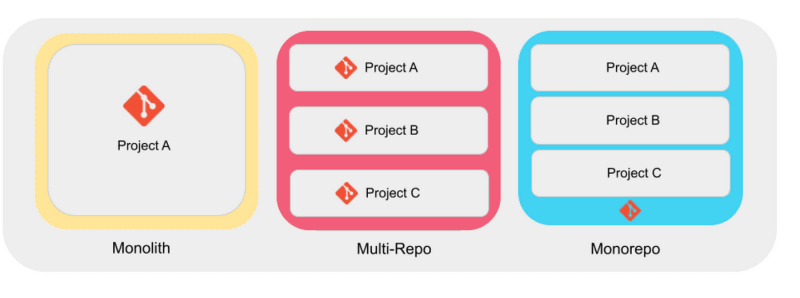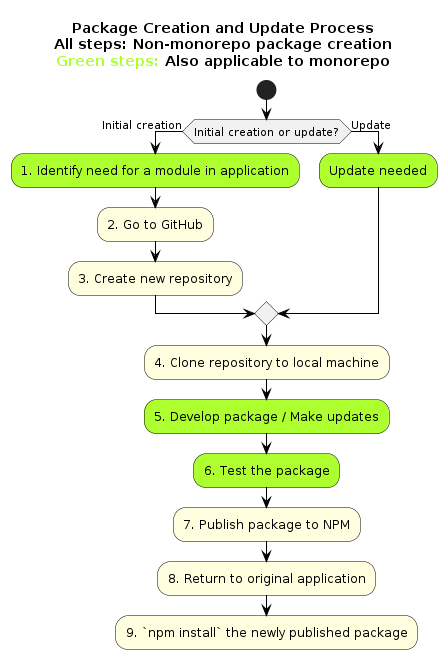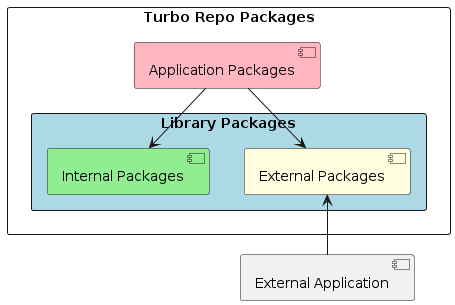Introduction: Unraveling the Modular Mystery
When you hear “monorepo”, you might be thinking, “A single repository for all projects? Wouldn’t that lead to a tangled mess?” And you wouldn’t be alone in that initial reaction. But here’s where it gets interesting: what if I told you that this approach actually leads to more modular, flexible, and efficient code? This is the unexpected reality that tech giants like Google, Uber, and reportedly even Meta (formerly Facebook) have discovered. Google, for instance, keeps a staggering 95% of their codebase in a single repository, with each project retaining its independence. Uber transformed their Android development with a monorepo approach, reaping benefits that we’ll explore later.
Understanding Monorepos
Before we dive into the benefits, let’s clarify what exactly a monorepo is and how it differs from traditional multi-repository setups. A monorepo, short for monolithic repository, is a version control strategy where multiple projects or components are stored in a single repository. This approach contrasts with the more traditional multi-repo setup, where each project or component has its own separate repository. In a multi-repo setup, you might have separate repositories for your frontend, backend, shared libraries, and documentation. Each of these would be managed independently, with its own version control history, issue tracking, and release cycles.
A monorepo, on the other hand, brings all of these components under one roof. Using Turborepo architecture, your directory structure might look something like this:
In a multi-repo setup, you might have separate repositories for your frontend, backend, shared libraries, and documentation. Each of these would be managed independently, with its own version control history, issue tracking, and release cycles.
A monorepo, on the other hand, brings all of these components under one roof. Using Turborepo architecture, your directory structure might look something like this:
- Independent Packages: Each project or package has its own
package.jsonfile, allowing it to manage its dependencies independently. - Shared Resources: While packages are independent, they can easily share and reuse code from other packages within the monorepo.
- Workspace Management: Tools like Turborepo and PNPM workspaces allow for efficient management of these multiple packages.
- Centralized Configuration: The root
package.jsonandturbo.jsonfiles allow for centralized configuration and script definitions.
Real-World Benefits: How Monorepos Transform Development Teams

Improved Modularity and Code Reuse
One of the most significant benefits of monorepos is the improved modularity and code reuse they enable. This, imho, primarily comes from the ease of creating new packages or apps inside of a monorepo, instead of needing to go through the entire process of creating a new repository. With a monorepo setup, you can easily create shared libraries, utilities, or components that can be used across multiple projects. This encourages developers to think in terms of reusable, composable pieces of code, leading to cleaner, more maintainable codebases.
Enforcing Code Quality and Consistency
Monorepos are a powerful tool for enforcing code quality and consistency. With shared configurations for tools like ESLint, Prettier, and TypeScript, gone are the days of debates over code style or formatting. These standards are automatically enforced across all projects, leading to a more uniform, maintainable codebase.Breaking Down Silos & Fostering Unified Team Knowledge
Perhaps one of the most significant advantages is how monorepos break down the silos between frontend, backend and blockend (web3) teams. In a world where full-stack development is increasingly valuable, monorepos naturally encourage developers to explore beyond their comfort zones. A frontend developer might find themselves exploring backend code to understand an API, while a backend developer might delve into the frontend to see how their endpoints are being used. This cross-pollination of knowledge leads to more robust, thoughtfully designed systems. This helps foster a sense of unified team knowledge. When the entire codebase is accessible to everyone, it promotes a holistic understanding of the system. Knowledge sharing becomes easier, and cross-training between frontend and backend teams happens organically. This leads to a more versatile, adaptable team that can tackle challenges more effectively.Embracing DRY Principles
The principle of Don’t Repeat Yourself (DRY) becomes much easier to adhere to in a monorepo setup. Shared packages for common functionality become the norm rather than the exception. This not only reduces code duplication but also makes refactoring a breeze. When you need to update a shared piece of functionality, you can do so in one place and see the effects ripple through your entire system. ⚠️ The flipside for multi-repo setups is that you might end up with multiple implementations of the same functionality due to developers being in silos, each with its own quirks and bugs. This can lead to inconsistencies and maintenance headaches down the line.Streamlined Releases and Versioning
When it comes to releases and versioning, monorepos shine. Tools like Changesets allow for coordinated releases across multiple packages. Automated changelog generation means your documentation always stays up-to-date with your code. This level of coordination is difficult, if not impossible, to achieve with traditional multi-repo setups.Simplified Dependency Management
Managing dependencies in a large, multi-project system can be a nightmare. But in a monorepo, it becomes significantly more manageable. With tools like PNPM and Turborepo, you can ensure consistent versions of dependencies across all your projects. Updating a shared dependency becomes a single operation rather than a coordinated effort across multiple repositories.Faster Onboarding
Imagine a new developer joining your team. In a traditional multi-repo setup, they might spend days, if not weeks, getting their environment set up, cloning multiple repositories, and figuring out how different parts of the system interact. With a monorepo, this process is dramatically simplified. One clone, and they have access to the entire codebase. The standardized setup across all projects means they can hit the ground running, contributing meaningful code within days rather than weeks.Turbocharging Build Performance with Intelligent Caching
Build performance is another area where monorepos, especially those using Turborepo, excel. The intelligent caching and parallel execution capabilities mean your builds are often significantly faster. Only rebuilding what has changed saves precious time in CI/CD pipelines, leading to faster feedback loops and more frequent deployments.Case Study: Uber’s Journey to Android Monorepo
 Uber’s transition to a monorepo for their Android codebase offers a compelling real-world example of how monorepos can significantly improve a development team’s workflow.
Uber’s transition to a monorepo for their Android codebase offers a compelling real-world example of how monorepos can significantly improve a development team’s workflow.
Background
Uber started with a single repository for their Android rider app in 2010. As the company grew, they transitioned to a multi-repo structure in 2013-2014 to address issues like long build times and feature coupling. However, by 2016, this multi-repo setup began to reach its limits.Challenges with Multi-Repo
- Architecture Silos: Different teams were using a variety of patterns and architectures, leading to a steep and consistent learning curve for developers working across libraries.
- Dependency Hell: As the dependency graph grew in complexity, managing and updating dependencies became increasingly time-consuming and error-prone.
- Long Build Times: Fresh app builds could take over 15 minutes, significantly hampering developer productivity.
The Monorepo Solution
In 2016, Uber decided to invest in a monorepo structure. This decision allowed them to:- Improve IDE Support: They optimized IntelliJ for their large codebase, enhancing developer experience.
- Reduce Build Times: By switching from Gradle to Buck (a modular build system), they reduced fresh build times from 15+ minutes to under 5 minutes, and incremental builds to under 1 minute.
- Maintain a Clean Master Branch: They introduced a “Submit Queue” system that rebases changes and runs tests before merging, preventing broken builds.
Results
The transition to a monorepo, coupled with investments in tooling, led to significant improvements:- Faster Builds: Build times were reduced by over 66% for fresh builds and even more for incremental builds.
- Improved Code Quality: The Submit Queue system helped maintain a consistently stable master branch.
- Enhanced Developer Productivity: With faster builds and better tooling, developers could iterate more quickly and efficiently.
- Scalability: The monorepo structure, supported by custom tooling, allowed Uber to continue scaling their Android development as the company grew.
Key Takeaway
Uber’s experience demonstrates that while transitioning to a monorepo requires significant investment in tooling and infrastructure, it can lead to substantial improvements in developer productivity and code quality, especially for large, rapidly growing codebases.Package Structure in Turbo Repos
In a Turborepo, packages are organized in a way that maximizes reusability and maintainability. Let’s break down the package structure:
Types of Packages
Application Packages
- These are the end-user applications in your monorepo.
- They can depend on both Internal and External Library Packages.
- Examples: Web applications, mobile apps, or backend services.
Library Packages
These are further divided into two categories: Internal Packages- Used only within the Turborepo.
- Not published to npm or other package registries.
- Provide shared functionality across your applications.
- Examples: Shared UI components, utility functions, or internal business logic.
- Can be used both within the Turborepo and by external applications.
- Typically published to npm or other package registries.
- Provide functionality that can be useful beyond your specific project.
- Examples: Open-source libraries, SDKs, or API clients.
Package Relationships
- Application Packages can depend on both Internal and External Library Packages. This allows your applications to leverage shared code efficiently.
- External Applications (outside your Turborepo) can only use your External Packages. This maintains a clear boundary between your internal code and what you expose to the outside world.
Tools that Power Monorepo Efficiency
The true power of a monorepo is unleashed when combined with specialized tools designed to optimize workflows. Let’s explore the key tools that supercharge monorepo efficiency in a Turborepo setup: Turborepo itself, Changesets, and PNPM.Turborepo: The Core of Monorepo Optimization
Turborepo is a high-performance build system designed specifically for JavaScript and TypeScript monorepos. Key features:- Intelligent Caching: Turborepo caches task outputs, dramatically speeding up subsequent builds by only rebuilding what’s changed.
- Parallel Execution: It runs tasks across multiple packages in parallel, significantly reducing overall build time.
- Remote Caching: Share build caches across your team or CI/CD pipeline to further optimize build times.
- Task Pipeline: Define dependencies between tasks across your entire monorepo.
turbo.json:
Changesets: Streamlining Versioning and Changelogs
Changesets is a tool for managing versions and changelogs in a monorepo setup, which integrates seamlessly with Turborepo. Key features:- Version Management: Easily bump versions of packages that have changed.
- Changelog Generation: Automatically generate and update changelogs.
- Release Management: Streamline the process of publishing packages.
PNPM: Efficient Package Management
PNPM (Performant NPM) is a fast, disk-space efficient package manager that’s particularly well-suited for Turborepos.
- Content-Addressable Storage: PNPM stores all packages in a single place on your disk and uses hard links to add them to your
node_modulesfolders.

- Strict Mode: Ensures that your projects only access the dependencies they’ve explicitly declared.
- Workspaces: Easily manage multiple packages in your monorepo, enabling local package linking without complex setup.
Streamlined CI/CD and Containerization
A well-structured monorepo, especially one using Turborepo, can significantly enhance your Continuous Integration and Continuous Deployment (CI/CD) processes. Furthermore, it integrates seamlessly with containerization technologies like Docker.CI/CD in a Turborepo
Turborepo’s architecture lends itself well to efficient CI/CD pipelines. Here’s how:- Incremental Builds: Turborepo only rebuilds what has changed, significantly speeding up CI processes.
- Parallel Execution: Tasks across multiple packages can run in parallel, reducing overall build time.
- Caching: Turborepo’s caching mechanism can be leveraged in CI environments to speed up subsequent builds.
Docker in a Turborepo
Turborepo works well with Docker, allowing you to containerize your applications efficiently.- Individual Dockerfiles: Each application in your
apps/directory can have its own Dockerfile. - Docker Compose: At the root of your Turborepo, you can use Docker Compose to define and run multi-container applications.
Navigating the Challenges of Monorepo Architecture


